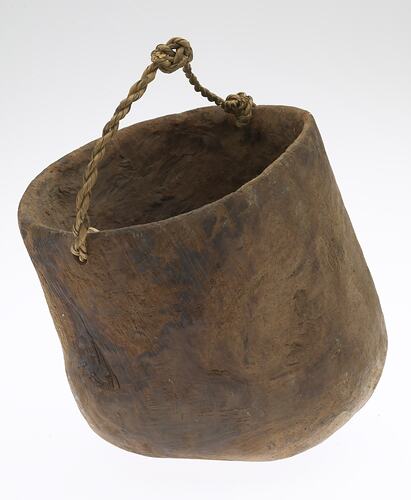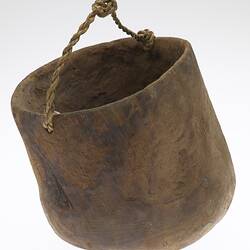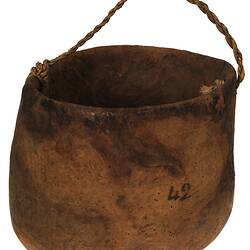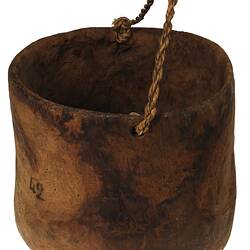Summary
The tarnuk (wooden bucket) was an essential item when travelling distances across country where water may be in short supply. The women carried the tarnuk, filling it with fresh water when they reached a creek or waterhole.
The tarnuk is made from a hollowed out burl of a River Red Gum, with a strong handle made from the inner bark of the Stringybark tree. The tarnuk can be made very thin and smooth through hollowing out the inside and scraping it with a bone or shell scraper. The bark covering the burl, or more often the layer of wood next to the bark, was used for the water-carrying tarnuk, as this was the lightest material; and ensured that even when filled with water, the tarnuk was not too heavy to be carried.
The much larger version, called tarnuk bullito, weighing up to nine kilos was used to store water in camps, as they were too heavy to carry long distances.
Local Name
Tarnuk
Physical Description
Wooden container with a plant fibre carrying handle. The wooden container is made from a single piece of densely grained hardwood, with a structure similar to a root burl. The shape is roughly cylindrical with a rounded base. The exterior is much more smoothly finished than the interior, but still has large areas of visible tool marks. The rim is rounded. There are two holes on opposite sides close to the rim, through which the carry cord passes through. The cord is in two parts, both two plied twisted plant material with one cord shorter and thicker than the other. The thinner cord passes thorough one hole in the container and is tied to itself in a complex knot. The thicker cord has a large knot at the end to prevent it slipping through the hole. The two cords are knotted together, somewhat off-centre. The number '42' is written on the outside in black ink.
Significance
This tarnuk came from the Mortlake area of the Western District of Victoria. The Girai Wurrung people are the Traditional Custodians of the land south-east of Lake Bolac, including Mortlake and Mt Hamilton.
It is known that the Girai Wurrung shared a close relationship with surrounding groups and had regular gatherings at Mirraewuae Swamp, east of Gariwerd (Grampians) to hunt and conduct ceremony with the Wadawurrung, Djab Wurrung, and Dauwurd Wurrung. There is also evidence the Girai Wurrung and Wadawurrung met at Lake Bolac together with the local Djab Wurrung clans to feast as part of the annual early Autumn eel migrations - a time of abundance where many hundreds could gather for ceremony and celebrations and be catered for.
More Information
-
Object/Medium
Container
-
Maker
-
Locality
-
Date Produced
-
Object Measurements
265 mm (Length), 210 mm (Width), 240 mm (Height)
-
Classification
-
Date Made
-
Maker
-
Clan/Language Group
-
Place Made
-
Indigenous Region
-
Keywords
-
References
[Book] 1992. Women's work: Aboriginal women's artefacts in the Museum of Victoria.
-
Type of item
-
Discipline
-
Category
-
Collecting Areas







